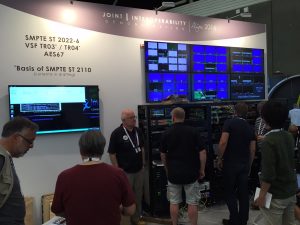IP Interoperability Takes Step Forward at IBC
The Alliance for IP Media Solutions (also known as the AIMS Alliance or simply AIMS) had a ubiquitous presence at the recent IBC 2016 in Amsterdam. Dozens of manufacturers looked to demonstrate their commitment to the Alliance and the SMPTE ST-2110 standard, which is currently in draft form but is expected to solve many of the issues that today make IP-based production and signal transport in a video facility less than perfect.

The IP Interoperability Zone gave IBC attendees a hint at a future with full interoperability for IP-based production.
The proof of concept came in the form of the IP Interoperability Zone at the show, which brought together IP-based production equipment from various vendors and was supported by various industry associations. The highlight was a “Sandbox LiveIP Studio” from VRT Belgium, which was used as a live TV studio for the trade show’s TV channel.
“I can’t remember the last time AES, the EBU, AMWA, SMPTE, and VSF all got together and had a coordinated effort to demonstrate something like this,” says AIMS Chairman Mike Cronk. “There used to be tape wars, and now the industry has come together in a way that it hasn’t before. Everyone involved has an extreme sense of accomplishment, but there are more steps to be taken.”
Cronk describes AIMS as a not-for-profit trade alliance comprising members that support the concept of IP signal transport but also know that the value of that transport is directly proportional to the number of people, companies, and systems using the same standard.
“If we fragment. there isn’t a lot of value,” he says. “But, if you want to use open standards and specifications and identify a roadmap, then join AIMS.”
The importance of SMPTE SD2110, which is currently in its drafting stage, cannot be undersold: it will allow video, audio, and metadata to be separated into three different IP addresses, a move that will allow things like breakaway audio or adding a language track to be easily accomplished.
“It will mean much more flexibility for a production. At the VSF Interop meeting in Houston earlier this summer, there were 30 companies that proved they can also have interoperability via SD-2110,” says Cronk. “That is a pretty good achievement and shows that everyone is moving in the same direction.”
Simply put? “Talk of a format war has dissipated, and that is great for the industry,” he adds. “SMPTE SD-2110 will solve a lot of issues related to the comfort level of using IP.”
In the VRT studio, equipment from 14 vendors used the current 2022-6 standard for video (where the video, audio, and metadata elements cannot be separated) and AES67 for audio and no SDI gateways, demonstrating that IP end-to-end is a reality today.
“SMPTE ST-2110 will make it even better, and it will be a true SMPTE standard that everyone will be able to build equipment to,” says Cronk. “And more equipment choice means best-of-breed equipment can be used.”
The demonstration area also showed the importance of PTP (Precision Time Protocol) timing, which allows clock accuracy on a network in the sub-microsecond range.
“You can transport time information over the same switch without multiple cables, black burst, or timecode,” says Cronk. “And every RTP packet has a 64-bit time stamp so that all the cameras have the same time-stamp info, which opens up the door for creative things in the future.”
Also demonstrated was automated device discovery and registration.
“With this,” Cronk explains, “you can take a Grass Valley camera, a Sony camera, or another device, and, when you connect it to the network, it will automatically populate data about what the device is into the control system, shrinking the time for setup.”
Getting Pragmatic
While it was pretty clear that discussions about IP-based workflows and deployments were definitely a major focus at IBC 2016, there was also a serious dose of pragmatism among many broadcasters and production professionals.
“The SD-to-HD transition occurred over a number of years. The IP transition could take a long time because of capital-investment cycles,” adds Cronk. “Some can make the move to IP because they have a greenfield site; others will be SDI for a long, long time.”
So part of the industry conversation about IP is on how the industry will realistically get from SDI to IP without increasing cost and/or risk or disenfranchising staffers.
“There is still a need for forums where the industry can get together and discuss why someone should go IP, the business ramifications of it, and how operators react to going IP and how it makes a difference,” adds Cronk. “But what we had at IBC was an important first step.”
More important, he thinks there will be plenty of room for both traditional engineers and IP professionals: “The experience we have had in deployments is, a pure IP person can’t cut it, nor can a pure-video person. I think there is quite a bit of job security if you’re an engineer willing to learn a few things on the side. But, ultimately, it will get down to individual use case, what someone can do with IP, and whether or not there is a benefit.”
